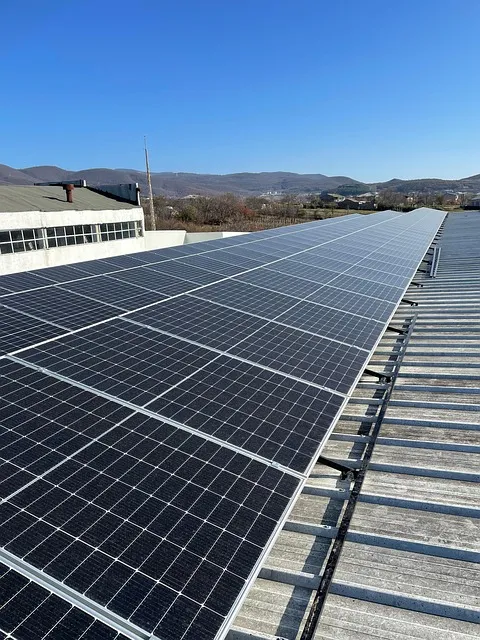Commercial roof installation requires careful consideration of structural integrity, durability, and aesthetics. Choosing between flat, pitched, or metal roofs impacts energy efficiency and building longevity. Engaging a skilled roofer is crucial; research their reputation, experience, licensing, insurance, and timeline. Material selection depends on climate, budget, and design, with options like asphalt shingles, metal panels, rubber, and PVC. The process involves assessment, underlayment, flashing, precise assembly, testing, and final inspection. Avoiding mistakes and consulting experts ensures a successful expansion. Future-proofing through regular maintenance prolongs roof lifespan, reducing costs and maintaining property value.
When businesses plan for construction or expansion, a new commercial roof is often top of mind. This crucial component protects your investment, ensures operational continuity, and contributes to energy efficiency.
This guide delves into the essentials of commercial roof installation, providing insights on everything from choosing the right materials to navigating the installation process. We’ll explore key considerations, common mistakes to avoid, and maintenance tips to ensure your commercial roof stands the test of time.
- Understanding Commercial Roof Installation: The Basics
- Key Factors to Consider Before Hiring a Commercial Roofer
- Types of Commercial Roofing Materials: A Comprehensive Guide
- The Step-by-Step Process of Commercial Roof Installation
- Common Mistakes to Avoid During Commercial Roof Expansion Projects
- Future-Proofing Your Business: Longevity and Maintenance Tips for Commercial Roofs
Understanding Commercial Roof Installation: The Basics

When businesses plan for construction or expansion, a new commercial roof is often part of the blueprint. Understanding the basics of commercial roof installation is essential for any business owner embarking on this project. This process involves careful consideration of various factors, including structural integrity, durability, and aesthetic appeal.
Commercial roofs differ from residential ones in their design and material choices. They typically need to withstand heavier loads, support larger areas, and endure harsh weather conditions. Therefore, roof build services often include specialized techniques such as steel framing, high-performance insulation, and advanced waterproofing membranes. The choice of commercial roof type, whether it’s flat, pitched, or metal, plays a significant role in determining the overall structure’s longevity and energy efficiency. A new roof install should be seen as an investment that can enhance the building’s value and ensure a secure future for the business beneath it.
Key Factors to Consider Before Hiring a Commercial Roofer

When it comes to commercial roof installation or expansion projects, hiring a qualified roofer is paramount. There are several key factors to consider before taking on this important task. Firstly, understand the diverse range of commercial roof types available, from flat roofs to steep-sloped designs, each requiring specific expertise and materials. This knowledge will help guide your choice of contractor who specialises in the appropriate roof build services for your project.
Secondly, research the roofer’s reputation, experience, and licensing. Ensure they have a proven track record with successful new roof installs and can provide references from previous clients. Check their insurance coverage to protect against any potential damages during the installation process. Additionally, understanding their project timeline and budget transparency is crucial for a smooth construction process that meets your expectations.
Types of Commercial Roofing Materials: A Comprehensive Guide

When it comes to commercial roof installation, understanding the available roofing materials is essential for any business owner or property manager. The choice of material can significantly impact the structural integrity, durability, and overall cost-effectiveness of a new roof install. Each type offers unique characteristics, catering to various environmental conditions and architectural designs. From traditional options like asphalt shingles to modern innovations such as metal panels, the market provides diverse choices for any commercial roof build services project.
As you explore commercial roof types, consider factors like climate, budget, and building design. Flat roofs, for instance, often use membranes or single-ply materials, known for their simplicity and cost-efficiency. On the other hand, metal roofing has gained popularity due to its superior strength and longevity, making it suitable for both low-slope and steep-slope applications. Additionally, rubber or PVC roofs are flexible options, offering excellent resistance to extreme temperatures and chemicals, which is ideal for industrial buildings. This comprehensive guide aims to empower businesses with the knowledge needed to navigate the selection process for their next roof build services project.
The Step-by-Step Process of Commercial Roof Installation

When businesses decide to construct or expand their facilities, a key consideration is choosing the right commercial roof installation. The process begins with an extensive assessment to determine the best roof type for the structure and local climate conditions. This could range from flat roofs ideal for low-slope applications to pitched roofs suitable for more extreme weather.
Next, the roofing contractor prepares the surface by ensuring it’s clean, dry, and free of debris. After that, they install underlayment and flashing to provide an extra layer of protection against moisture intrusion. The actual roof system is then assembled, using specialized equipment to secure the components. This step involves precise measurements, cutting, and sealing to create a watertight seal. Once complete, thorough testing ensures the new roof meets all safety standards before final inspection and acceptance by the client.
Common Mistakes to Avoid During Commercial Roof Expansion Projects

When embarking on a commercial roof expansion project, steering clear of common pitfalls is essential to ensure a seamless and successful outcome. One blunder often made is neglecting to thoroughly assess the existing structure. Before beginning any construction, it’s crucial to evaluate the current roof’s condition, load-bearing capacity, and structural integrity. This step is vital as it guides the decision-making process for materials, designs, and techniques used in the expansion. Ignoring this assessment can lead to costly repairs or even safety hazards later on.
Another mistake to avoid is selecting an unsuitable roofing material or system. Commercial roofs demand durable and weatherproof solutions tailored to specific building types and climates. Rushing into a decision without considering local environmental factors, architectural requirements, and long-term maintenance implications can result in a subpar new roof install. Consulting with experienced professionals offering comprehensive roof build services can help business owners choose the most suitable commercial roof types for their projects, ensuring both functionality and aesthetics.
Future-Proofing Your Business: Longevity and Maintenance Tips for Commercial Roofs

When businesses consider a commercial roof installation or expansion, future-proofing is key. A well-installed and maintained commercial roof can extend its lifespan significantly, reducing replacement costs in the long run. This involves choosing durable materials suitable for local climates and environmental conditions – from asphalt to metal, each has unique benefits and longevity guarantees. Regular maintenance checks are crucial; addressing issues early prevents costly repairs later.
Regular inspections, cleaning, and repairs are essential components of roof build services that ensure your commercial roof’s optimal performance. Staying proactive allows you to identify potential problems before they escalate, ultimately saving money and maintaining the integrity of your property. By prioritizing these practices, businesses can enjoy a secure and reliable roofing system that complements their operations for years to come, enhancing the overall value of their investment in new roof install.
